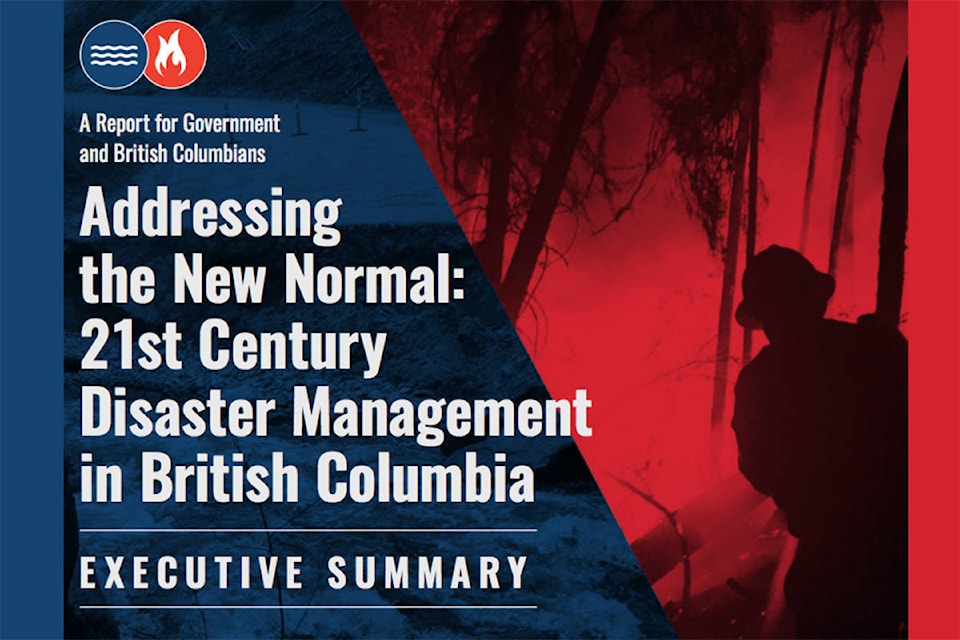The Addressing the New Normal: 21st Century Disaster Management in British Columbia report makes 108 recommendations for both prevention and dealing with flooding or wildfires.
“Their 108 recommendations will take some time to fully consider. There are some recommendations that are being acted on already. For example, as part of Budget 2018, we’re committing $50 million over three years to wildfire prevention and wildfire risk reduction around communities,” said Doug Donaldson, Minister of Forests, Lands, Natural Resource Operations and Rural Development.
Here’s a breakdown of some of the recommendations:
First Nations
A large number of the recommendations focus on working with Indigenous governments and communities. These include things such as establishing true partners and leaders in emergency management by including First Nations from the beginning, ensuring emergency services available to First Nations are comparable to other communities of similar size and location, developing a youth leadership program and building cultural sensitivity training and awareness of racism and discrimination into emergency management plans.
Co-ordination
The report also recommends developing strategic partnerships and operational agreements with others such as key community members, forest professionals, First Nations, tenure holders (forest, range, guide outfitters and others), as suitable to provide increased response capacity and promote resilience across the land base. Examples include developing a partners’ program where, prior to wildfires, local resources are assigned to containment line teams consisting of heavy equipment, forest professionals, technicians and workers who use their local knowledge and expertise to establish containment lines as part of tactical operations; and a preferred contractor procurement model for the BC Wildfire Service to be offered as an option to standing offer participants.
Furthermore, it’s recommended to establish more area based tenures such as community forests and woodlots.
Preparedness
Many of the recommendations deal with preparedness such as establishing emergency centres of excellence in Interior locations to support large scale disaster response, holding workshops and forums and establishing mutual aid agreements, as well was improving integration between governments.
Equipment
Some of the recommendations for equipment include establishing equipment caches for rural and remote communities as well as leveraging economies of scale to reduce costs for external sprinkler systems for residents.
Flooding specific
Flooding specifically, the report calls for reviews of plans, flood evaluations, models and risk modelling.
Communications
About 50per cent of survey respondents indicated dissatisfaction on communications. The report recommends building a central hub or ‘onestop shop’ emergency communications website to provide the public with reliable, responsive, adaptive, real-time and customer-focused information. This hub should collect information from provincial departments and agencies, First Nations and local governments and relevant stakeholder agencies, including media. It should also provide emergency updates for evacuees and include citizen information on how to assist, volunteer or donate.
Related: Report: Only one-third of respondents felt their community was prepared for a future wildfire
Capacity building
Part of the recommendations, deal with building capacity to deal with large-scale disasters. This includes providing extra training such as increasing the number of basic firefighters by providing open access to S-100 training for all natural resource sector staff, industry, First Nations, communities, ranchers and other tenure holders as well as creating training courses.
Fire safety incentives
The report also calls for improvements to buildings’ fire safety such as mandating the insurance industry to create incentives for building with fire-resistant materials, as well as adjusting building codes and bylaws.This also includes a wide range of community FireSmart objectives.
Burning
Some recommendations call for applicable ministries to reconcile status limiting burning. Going a step further, it recommends fire to be established as a management objective, to increase to use of burning as a tool to reduce risk and assess the posibility of a prescribed burn statute that would for protection for responsible and permitted burners.
No rotation of IMT
It’s recommended that the BC Wildfire Service eliminate the rotation of Incident Management Teams (IMTs) to various fires prior to containment. Support IMTs by creating specialized respite teams to transition and backfill IMTs or develop an alternate respite strategy.
New Carbon Tax
It’s recommended to create a carbon tax revenue stream to establish a predictable and stable revenue stream along with a strategy on how to prioritize funds.
Salvage
Salvage fire-damaged timber in a manner that maximizes economic, ecological and other values, and is well-coordinated and communicated with licenced resource users on the land base as well as removing disincentives for removing burned wood and developing replanting strategies.
For the full recommendations, see the executive summary below:
BC Flood and Wildfire Review Addressing the New Normal 21st Century Disaster Management in BC Executive Sum... by Max Winkelman on Scribd
